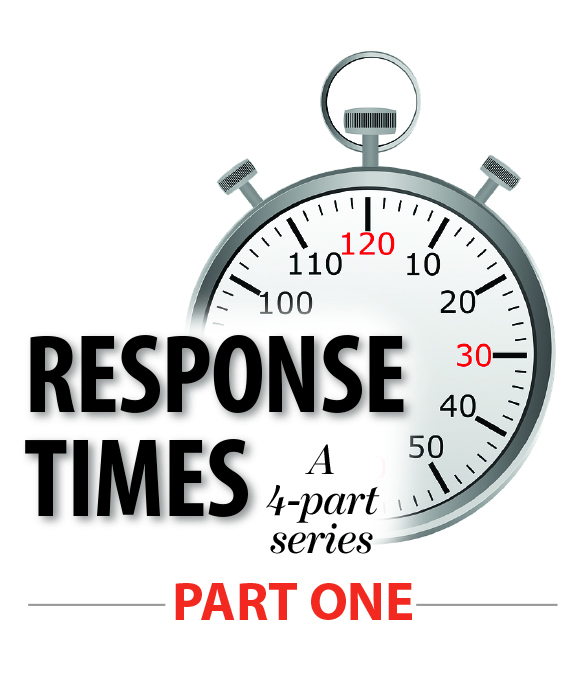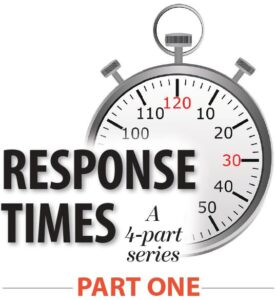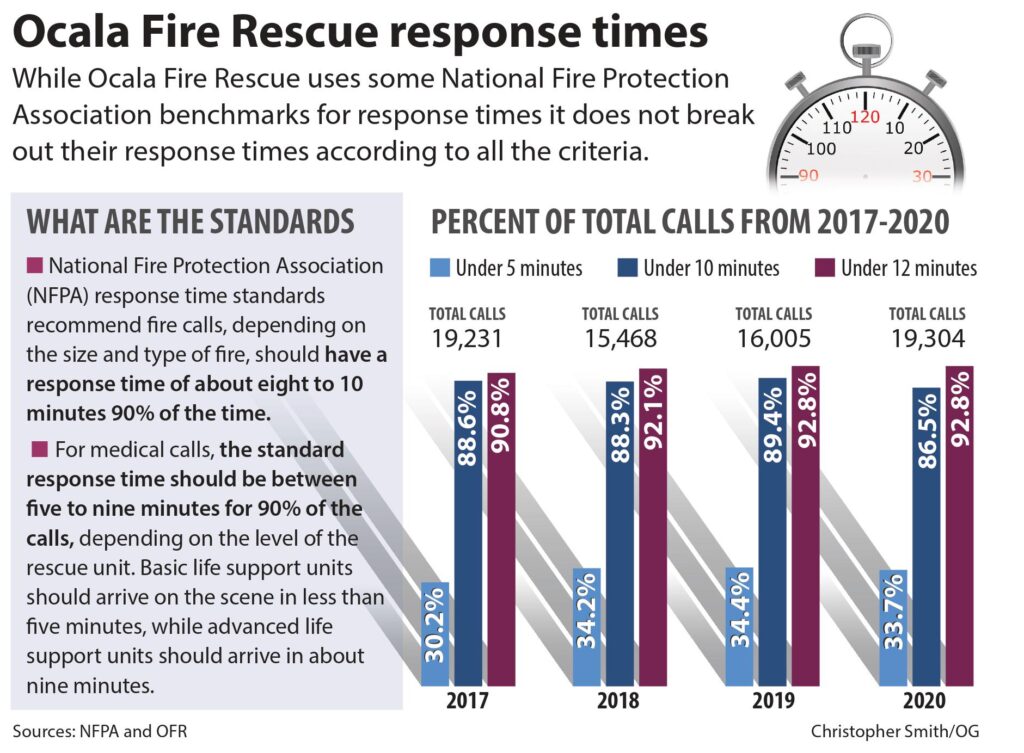Response time important to emergency outcomes


[Bruce Ackerman/Ocala Gazette]
 Ocala Fire Rescue arrives at emergency scenes in under 10 minutes more than 86% of the time, according to 2020 data for total calls.
Ocala Fire Rescue arrives at emergency scenes in under 10 minutes more than 86% of the time, according to 2020 data for total calls.
That figure dropped from almost 90% last year after calls for service increased more than 20%. Emergency calls jumped from about 16,000 to 19,000, according to OFR data.
Response times are considered a vital component in outcomes in an emergency. Research has identified a window known as the “golden response time,” which is the 15-20 minutes after an accident. It’s the time where emergency medical services are most beneficial.
Multiple studies point to response times as a factor in the survival rates of crash victims across the country. Another study published in the Journal of the American Heart Association showed EMS response times were linked to the survival of those who suffered heart attacks outside of a hospital.
With response times so critical in an emergency, local agencies strive to keep them low.
Ocala Fire Rescue Chief Clint Welborn said the department strives to meet some of the National Fire Protection Association (NFPA) response time standards.
The 10-minute mark is one of the national standards published by the NFPA for structure fire calls.
The standard recommends fire calls, depending on the size and type of fire, should have a response time of about eight to 10 minutes 90% of the time.
For medical calls, the standard response time should be between five to nine minutes for 90% of the calls, depending on the level of the rescue unit. Basic life support units should arrive on the scene in less than five minutes, while advanced life support units should arrive in about nine minutes.
OFR does not break out their response times according to those criteria, according to Ashley Lopez, an OFR spokeswoman.
In 2020, almost 93% of all OFR’s calls had a response time under 12 minutes. Further, 86.55% of calls were under 10 minutes, 22.74% were under five minutes, and 33.74% of all calls had response times under five minutes.
Outside factors
Many things affect response times.
The time of day can be one factor. At busier times, emergency vehicles have to navigate heavier traffic.
Additionally, Lopez said the proximity of the responding station to high-congestion areas and special traffic pattern areas such as school zones can impact response times.
Lopez said response times are one of many metrics used to track potential areas for improvement.
Studies have shown wholesale efforts to reduce response times could be wasteful. Instead, response times are one measure of effectiveness.
 A piece of the puzzle
A piece of the puzzle
Welborn said understanding and measuring response times is something OFR does, and he makes sure everyone knows the numbers.
“Utilizing these measures and making them known to our personnel and saying, ‘Hey, this is the response times for this shift, this shift and this shift,’ helps to get them quicker,” he said.
But he cautioned it’s not all about how fast units can get somewhere. Firefighters and public safety come first, he said, even if it means a slightly longer response time.
“At the same time, our men and women are being safe. They have to get there safe also,” he said. “We don’t pass busses when they’re stopped. We turn our lights off in school zones; we turn our sirens off in school zones.”
Those factors must be taken into account when reviewing response times, according to Welborn.
“We have to be able to decipher and look at them, and analyze them so if we have an anomaly, we can look into it and say why that took place,” he said. “With that being said, utilizing these call times does help us increase our performance and increase the benefit to the citizens of Ocala.”
Analyzing response times not only helps streamline the response process but can help with strategic planning and forecasting.
“When it comes to building stations, moving stations, all that data allows us to make the right decisions when those times come,” Welborn said. “Maybe this station shouldn’t be responding to this location. Even though it might be closer as the crow flies, this one’s closer by street blocks.”
Welborn said COVID-19 has influenced the number of calls, but not response times.
“There’s always an effect. For us, initially, the call load kind of went down. Now, with obviously where we are, the call load has gone up,” he said. “But, other than the call load rising, there really isn’t a shift in how we’ve operated other than adding safety precautions to keep our personnel and the patients safe.”
Welborn noted that while their call volume increased in 2020, they still responded to 11% of all calls in under three minutes.
“Our times improved, which I’m thrilled about. Can we improve overall? Absolutely… We’re going to strive to always improve,” he said.
While response times are important, Welborn said they are just one tool in the kit.
“We also have other measures we’ve created to measure the efficacy of the treatment we’re giving on-scene. We want to know that we’re getting on scene and making a difference,” he said. “It’s not always just about how fast you get there. It’s also how you treat the patient and is the treatment working.”





